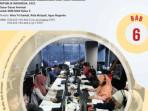Kunci Jawaban
Simak Kunci Jawaban Bahasa Inggris Kelas 10 Kurikulum Merdeka Halaman 112, 113 dan 114 Chapter 5
Berikut ini kunci jawaban Bahasa Inggris Kelas 10 Halaman 112, 113, 114 Kurikulum Merdeka, Chapter 5: Graffiti
Penulis: Yonatan Krisna Halman Tri Santosa
Editor: Yonatan Krisna
TRIBUNWOW.COM - Berikut ini kunci jawaban Bahasa Inggris Kelas 10 Halaman 112, 113, 114 Kurikulum Merdeka, Chapter 5: Graffiti.
Soal dari kunci jawaban ini terdapat pada buku Bahasa Inggris: Work in Progress untuk SMA/SMK/MA Kelas X yang disusun oleh Budi Hermawan dkk yang diterbitkan oleh Pusat Perbukuan Kementerian Pendidikan, Kebudayaan, Riset, dan Teknologi (Kemendikburistek) tahun 2022.
B. Let’s Answer
Read the statements and decide if they are found/discussed in either Expository Text 1 or Expository Text 2. Tick the appropriate box.
Tick both, if the statement is found/discussed in both Expository Text 1 or Expository Text 2.
Tick neither, if the statement is not found/discussed in both Expository Text 1 or Expository Text 2.
Read the two texts again carefully this time, pay attention to the details, then select the best answer.
Answer/Jawaban:
- Graffiti is art – text 1
- Graffiti is always vandalism – text 2
- Graffiti is celebrated by those who are juvenile – text 2
- Graffiti connects the public and the artist – text 1
- Graffiti turns simple building into a masterpiece – text 1
- Graffiti has the power to affect people positively – text 1
- Graffiti is committed without permission on another person’s property – text 2
- No two pieces of graffiti are the same – text 1
- Physical disorder and vandalism have a contagious effect – text 2
- Everyone is meant to be appreciated – text 1
- The one who created graffiti is usually involves in other crimes as well – text 2
C. Let’s Compare
Compare Expository Text 1 and Expository Text 2 by completing the table.
Answer/Jawaban:
What is the author claiming?
Expository Text 1: Graffiti should be considered a form of art.
Expository Text 2: Graffiti is always vandalism.
What reasons does the author use to support the claim?
Expository Text 1: It connects people, expresses identity, affects others positively, and is unique.
Expository Text 2: It’s done without permission, disrespects property, and encourages disorder.
What evidence does the author include?
Expository Text 1: People engage with graffiti, watch artists paint, share feedback, and appreciate its uniqueness.
Expository Text 2: Museum policies, John Lindsay’s anti-graffiti actions, and a 2008 Netherlands study.
What does the author say as the closing?
Expository Text 1: People should learn about graffiti’s origins to foster understanding and positivity.
Expository Text 2: Graffiti marks areas as unsafe and is linked to further crime.
D. Let’s Discuss





